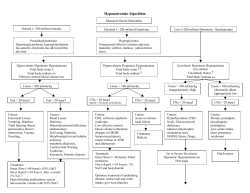
1.85 WATER AND WASTEWATER TREATMENT ENGINEERING HOMEWORK 5
1.85 WATER AND WASTEWATER TREATMENT ENGINEERING HOMEWORK 5 Question 1 (4 points) The water defined by the analysis given below is to be softened by excess-lime (and soda ash) treatment. a. Sketch an meq/L bar graph (1 point). b. Calculate the softening chemicals required (3 points). c. Draw a bar graph for the softened water after recarbonation and filtration, assuming that 80% of the alkalinity is in the bicarbonate form (1 point). CO2 8.8 mg/L 2+ 40.0 mg/L ALK (HCO3 ) 2+ 14.7 mg/L + 13.7 mg/L – SO42 – Ca Mg Na – Cl ANSWER – See solution to follow 1 135 mg/L 29.0 mg/L 17.8 mg/L Solution for Homework 5, Problem 1 Ion Cations Charge MW Anions Conc (mg/L) Equiv. (meq/L) Ion MW Conc (mg/L) Equiv. (meq/L) CO2 44 2 8.8 0.40 Ca2+ 40 2 40 2.00 Alk (HCO3–) 50 1 135 2.70 2+ Mg 24.3 2 14.7 1.21 SO42– 96 2 29 0.60 Na+ 23 1 13.7 0.60 Cl – 35.5 1 17.8 0.50 Total anions: 3.81 Check charge balance: Total cations: 3.81 a. Sketch an meq/L bar graph 0.4 0 2.00 3.21 Ca 3.81 meq/L Na Mg CO2 SO4 HCO3 0.4 0 2.70 Note: scale is approximate but numbers are accurate to two digits. Hardness = 3.21 meq/L 160 mg/L as CaCO3 Strong bases = 3.81 meq/L 190 mg/L as CaCO3 Strong acids = 1.11 meq/L 55 mg/L as CaCO3 Alk = 2.70 meq/L 135 mg/L as CaCO3 Carb hardness = 2.70 meq/L 135 mg/L as CaCO3 Ca carb hardness = 2.00 meq/L 100 mg/L as CaCO3 Mg carb hardness = 0.71 meq/L 36 mg/L as CaCO3 Non-carb hardness = 0.51 meq/L 25 mg/L as CaCO3 Mg NCH = 0.51 meq/L 25 mg/L as CaCO3 b. Calculate the softening chemicals required Lime requirement: mg/L as CaCO3 Component Lime as CaCO3 Lime for CO2 CO2 20 0.40 20 Lime for Ca CH Ca(HCO3)2 100 2.00 100 Lime for Mg CH Lime for non-carb hardness Mg(HCO3)2 NCH 36 25 0.71 0.51 Total lime needed Total 181 3.62 Total lime as CaO Plus excess lime Total lime including excess * Note Mg carbonate hardness requires double lime dose Homework 5.xls Problem 1 2/26/2006 meq/L 121 mg/L as CaO 35 mg/L as CaO 156 mg/L as CaO 71 * 25 216 Cl 3.30 3.81 meq/L Solution for Homework 5, Problem 1 Soda ash requirement: mg/L as CaCO3 Component meq/L Soda as CaCO3 Soda for non-carb hardness NCH 25 0.51 25 Total soda ash needed Total 25 0.51 25 27 mg/L as Na2CO3 Total soda ash as Na2CO3 c. Draw a bar graph for the softened water after recarbonation and filtration, assuming that 80% of the alkalinity is in the bicarbonate form 0 0.6 Ca CO3 0 Homework 5.xls Problem 1 2/26/2006 0.2 0.8 1.91 Na Mg HCO3 SO4 0.8 Cl 1.4 1.91 Question 2 (2 points) A small community has used an unchlorinated ground-water supply containing approximately 0.3 mg/L of iron and manganese for several years without any apparent iron and manganese problems. A health official suggested that the town install chlorination equipment to disinfect the water and provide a chlorine residual in the distribution system. After initiating chlorination, consumers complained about water staining washed clothes and bathroom fixtures. Explain what is occurring due to chlorination. ANSWER: Chlorine is a strong oxidizer and is oxidizing the iron and the manganese. The oxidized iron and manganese is relatively insoluble and forms precipitates. These precipitates cause the stains on fixtures and laundry. Apparently, before chlorination, the iron and manganese remained dissolved or as fine colloids and passed through the system without causing problems. Question 3 (2 points) A wastewater containing phenol at a concentration of 0.4 mg/L is to be treated by granular activated carbon. Batch tests have been performed in the laboratory to determine the relative adsorption of phenol by GAC. Testing entails adding a mass of carbon to V = 1 liter of the 0.4 mg/L-solution, allowing the solution to reach equilibrium over 6 days, and then measuring the resulting equilibrium concentration of phenol. Results are shown in the table below. Develop a Freundlich isotherm to fit these data. Mass of carbon, M (gm) Initial conc., C0 (mg/L) Equilibrium conc Ce (mg/L) 0.52 0.400 0.322 2.32 0.400 0.117 3.46 0.400 0.051 3.84 0.400 0.039 4.50 0.400 0.023 5.40 0.400 0.012 6.67 0.400 0.0061 7.60 0.400 0.0042 8.82 0.400 0.0023 4 Answer: From spreadsheet calculation: Data tabulation: Mass of carbon, M Initial conc. C0 (g) 0.52 2.32 3.46 3.84 4.5 5.4 6.67 7.6 8.82 (mg/L) 0.4 0.4 0.4 0.4 0.4 0.4 0.4 0.4 0.4 Mass of adsorbent Equil. conc CA C0-CA V * (C0 - CA) qA = V (C0 - CA) / M (mg/L) (mg) (mg/g) 0.078 0.078 0.150 0.283 0.283 0.122 0.349 0.349 0.101 0.361 0.361 0.094 0.377 0.377 0.084 0.388 0.388 0.072 0.3939 0.3939 0.059 0.3958 0.3958 0.052 0.3977 0.3977 0.045 Solid phase Liquid phase Change in Mass concentration conc. in water adsorbed to concentration carbon (mg/L) 0.322 0.117 0.051 0.039 0.023 0.012 0.0061 0.0042 0.0023 log CA -0.492 -0.932 -1.292 -1.409 -1.638 -1.921 -2.215 -2.377 -2.638 log qA -0.824 -0.914 -0.996 -1.027 -1.077 -1.144 -1.229 -1.283 -1.346 Data are plotted below and fall more or less on a straight line. Determine approximate slope from first and last points on line: (Note that linear regression would be more accurate.) Slope = 1/n = [(log qA,max) - log (qA,min)]/[log(CA,max)-log(CA,min)] 1/n = 0.243 Next determine KF= qA / CA/n for each data point and find average KF value: Mass of carbon, M Equil. conc CA (g) 0.52 2.32 3.46 3.84 4.5 5.4 6.67 7.6 8.82 (mg/L) 0.322 0.117 0.051 0.039 0.023 0.012 0.0061 0.0042 0.0023 qA 1/n = V(C0-CA)/M KF = qA/CA (mg/g) 0.150 0.198 0.122 0.206 0.101 0.208 0.094 0.207 0.084 0.210 0.072 0.211 0.059 0.204 0.052 0.197 0.045 0.198 Average = 0.204 5 Data plot: qA 1.000 0.100 0.010 0.001 0.01 0.1 CA 6 1 Question 4 (2 points) An ion exchange resin is used to remove nitrate from a water supply with the ionic concentrations shown below. The total resin capacity is 1.5 equivalents per liter of resin. Cations meq/L Ca2+ Mg2+ Na+ Anions 1.4 0.8 2.6 meq/L – SO42 Cl 0.0 – NO3 3.0 – 1.8 d. Do the anions and cations balance? (1 point). e. What volume of water can be treated with each liter of resin? (2 points) – – f. Qualitatively, how would your answer differ if the concentrations of Cl and SO4 were reversed? (1 point). Answer: a. b. Σcations = 4.8 meq/L Σanions = 4.8 meq/L Charges balance!. Each liter of resin can remove 1.5 equivalents. Only chloride is present in quantity and nitrate is well above chloride in ion exchanger preference series shown in lecture, therefore can ignore exchange of ions other than nitrate: Concentration of nitrate = 1.8 x 10-3 eq/L Volume treated = 1.5 eq / 1.8 x 10-3 eq/L c. = 833 liters S ince SO4 is above NO3 in the preference series, if SO4 were present rather than Cl, SO4 would be adsorbed instead of NO3. There were would be far less, if any, NO3 adsorption. Another resin or much greater amount of resin would be needed. 7
© Copyright 2025
















